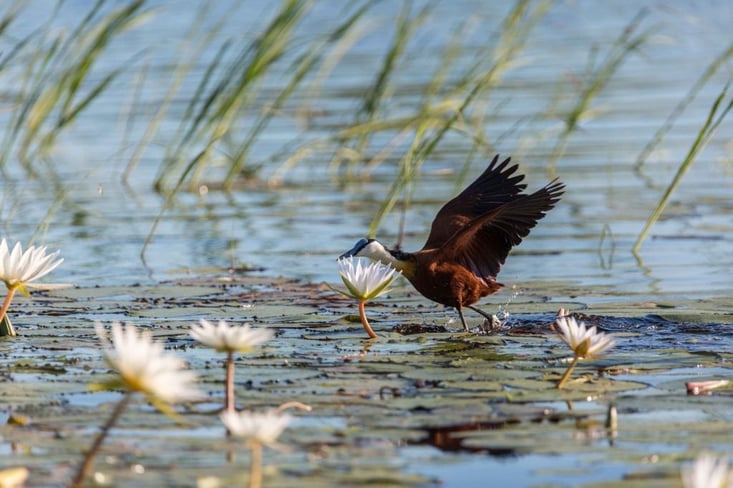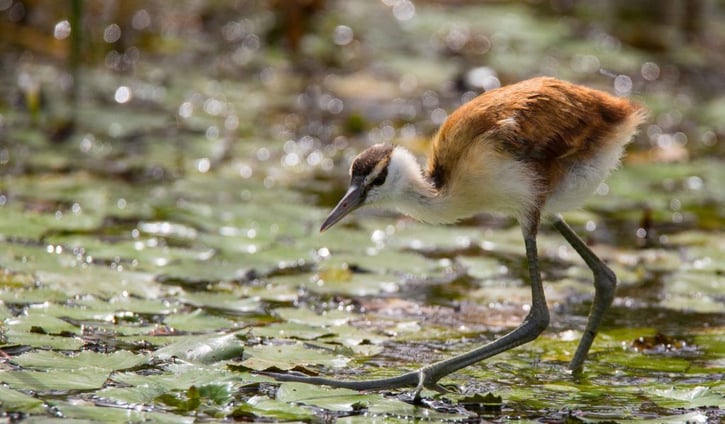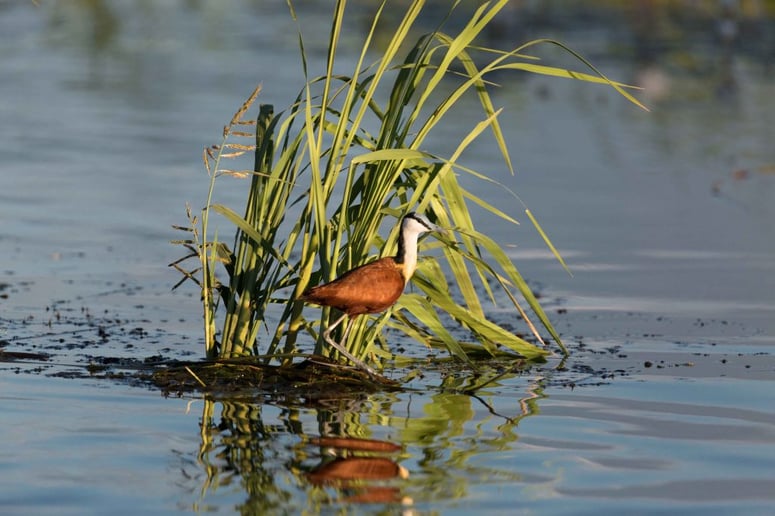My first encounter with an African jacana was in the Namib Desert – a rare, unthinkable place for these waders to occur, since they usually inhabit freshwater wetlands. Baby Jac, as I named the juvenile, must have been blown into the desert by the extreme winds that had been raging for the entire week of our trip along the Skeleton Coast. At least, this was our theory, because we knew their flying ability did not match their ability to walk on water. (Wait, what? Continue reading.)
The African jacana (Actophilornis africanus) mostly occurs in freshwater wetlands, such as the perennial rivers in the north of Namibia. They are found along the Okavango, Chobe and Zambezi rivers, the Orange River in the south, in the Etosha National Park, Swakopmund, as well as in the Okavango Delta and Moremi Game Reserve in Botswana. Scattered populations are also found in central and northern Namibia.
Here are ten fun facts about this fascinating bird:
- Jacanas can walk on water
I will not leave you hanging for too long, so let’s jump straight to it. Jacanas are also known as Jesus birds because of their ability to walk on water with their slender legs and curiously long toes. In fact, they technically walk on floating vegetation, which gives the impression that they are walking on water.
- A second nickname
This ability earned them their other nickname – lily-trotters. Many bird photographers capture jacanas walking on waterlilies where they spend most of their days searching for food such as aquatic insects and larvae, worms, snails and other arthropods.
- Jacanas are good swimmers and divers
When foraging, they swim over open water from one vegetated area to another. They can also swim underwater to avoid predators.
- Jacana chicks can swim just as well as their parents
In dangerous situations, the chicks can hide underwater with only the tip of their bills sticking out above the surface.
- They are weak fliers
As already mentioned, their flying ability does not match their ability to walk on water. The African jacana usually only flies short distances with their wings curved, legs hanging or held horizontally behind.
- Jacanas have … uhm, peculiar breeding habits
Jacanas have an unusual mating system called polyandry, meaning that one female mates with multiple males.
- The females lay their eggs in different males’ nests
… and do not even blink before moving on to the next one. Females can lay up to ten successive clutches of eggs in one season.
- The female is the protector
The female is the protector of the territory. This is probably directly linked to the fact that she is double the size of her hubby (or rather, hubbies).
- The males raise the chicks
The males are expert single dads, as they care for the chicks alone. They tend to all nesting duties from nest building to bringing up the chicks.
- Their nests are loose floating islands
Nests are built on small loose floating islands of marshy vegetation over deep water. They are partially submerged, with about 2 centimetres appearing above the surface.
For the best chance of catching a glimpse of these birds, book your stay at any of our Gondwana lodges in the north:
- Chobe River Camp
- Hakusembe River Lodge
- Namushasha River Lodge
- Zambezi Mubala Camp
- Zambezi Mubala Lodge
Can you share any other fun facts about the African jacana? What is your favourite bird? Which birds do you wish to see on your trip to the north of Namibia?
Annelien Robberts is an avid wordsmith who turns her pen to all things travel, culture, and lifestyle. She was born in a small town called Otjiwarongo and grew up on a farm nearby. Creativity, nature and animals make her happy.










SUBMIT YOUR COMMENT